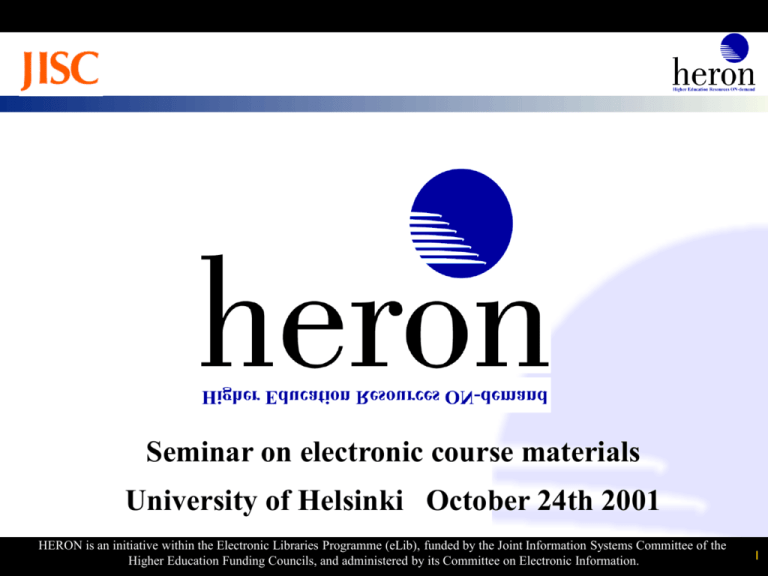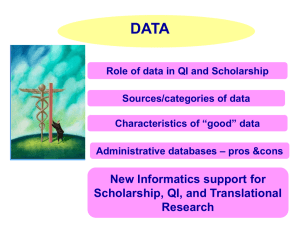Key issues for the HERON service
advertisement

Seminar on electronic course materials University of Helsinki October 24th 2001 HERON is an initiative within the Electronic Libraries Programme (eLib), funded by the Joint Information Systems Committee of the Higher Education Funding Councils, and administered by its Committee on Electronic Information. 1 Outline 1. The HERON Service why HERON was established what does HERON do key issues for HERON 2. The experience of Universities using the HERON service 3 case studies key issues for use of electronic readings 2 HERON background HERON: Higher Education Resources ON-Demand originally a phase 3 eLib project, now DNER built on experience gained from previous eLib projects such as SCOPE and ACORN funded by the JISC and run by a Partnership of three universities 3 The HERON Partnership University of Stirling Napier University (Edinburgh) South Bank University (London) (Blackwell Retail Ltd: Aug 1998 - July 2001) 4 What does HERON do? HERON provides a national service for the UK HE sector for copyright clearance, digitisation and delivery of electronic articles and book extracts HERON also has, uniquely in the UK, Trusted Repository status which allows us to build a resource bank of digitised material which is available to Higher Education Institutions at reduced cost and at short notice 5 The HERON Service The full service can be divided into 6 stages: members submit requests to HERON requests are copyright cleared through CLA or direct with rightsholders estimates of total costs are provided the estimate is accepted or rejected the material is digitised or a paper pack is created the request is delivered in its final format 6 The HERON Service The HERON Service is created from three strands: Liaison: with HERON Members and with rightsholders and suppliers Copyright Office: clearance through Copyright Licensing Agency (CLA) publishers and authors Technical Unit: digitisation and technical support both for the service and for Members 7 HERON Liaison The Liaison Officer: provides publicity about HERON is the first point of contact for would-be members provides information, presentations and support for all new and existing members organises HERON User Group meetings manages lis-hug - HERON’s closed email discussion list 8 HERON’s Copyright Office Copyright staff: provide centralised expertise and contacts enabling direct negotiation with publishers, rightsholders and the CLA. (HERON has now worked with over 1,000 publishers) provide a pressure group on behalf of HEIs to encourage understanding of the needs of HE negotiate to improve copyright clearance terms 9 HERON’s Technical Unit Technical Unit staff: manage the digitisation process to exacting standards deliver digitised files to HERON Members provide technical support for members and staff - including the creation of HERONweb a web based request management system tailored to the needs of HERON’s users 10 Key issues for the HERON service problems with the current UK copyright clearance pricing models currently available slow response from some publishers HEI Texts self supporting status - full cost recovery is hard to achieve in an immature market usage growing because of developments in distance learning and the arrival of Managed or Virtual Learning Environments (MLE / VLE) 11 Development of the HERON service August 1998: HERON Project initiated September 1999: pilot service for 5 members September 2001: 42 members over 10,000 requests submitted £140,000 (1,335,000FM) spent on digitised extracts from HERON new request management system successfully introduced streamlining many processes HERON has moved from Project into Service 12 Experiences of HERON users Every HERON Member uses the service and the texts we provide in a different way Case Studies: To demonstrate this I have chosen three case studies showing very different service models Key issues: an identification of key issues for universities in the provision of digitised texts for students 13 HERON Case Study 1 University of Derby Electronic Library (UDEL) Background information Reason: Initiated by the University Library in response to a move from teaching to resource based learning Aim: to provide high quality resources to enhance learning and widen access Funding: Project funding from internal funds for ‘Academic Development’ 14 Case Study 1: UDEL Year 1 1996/7 3 modules 36 digitised extracts managed by 1 f/t member of staff Reactions: Academics - enthusiasm UDEL staff - caution about expanding too fast until the system to manage these resources was developed 15 Case Study 1: UDEL Year 2 1997/8 Funding - Shared Academic Development Fund and Library 1 f/t member of staff 9 modules 134 digitised extracts Reactions: Academics - increasing confidence in the system and increasing demand for use of UDEL 16 Case Study 1: UDEL The UDEL model has been very successful and has continued to grow so that in 2000/1 Staffing: 3 staff (f/t equivalent) Funding: now from Library budget 67 modules over 600 digitised extracts Responses: Academic - ‘I would be unable to deliver courses the way I want to without the support of UDEL’ 17 Case Study 1: UDEL Issues for UDEL can only work with full support of tutors - they encourage the students to use the resources cannot work without an effective IT network students - initially alarmed by the technology system must be as user friendly as possible user education part of the UDEL service largest problem: the cost of copyright fees 18 Case Study 1: UDEL Successes students love it and want this service for all their modules once tutors have used UDEL, they increase their use in subsequent years - they see UDEL an efficient and reliable method of widening access to reading materials UDEL has now become a recognised service of the University of Derby 19 HERON Case Study 2 University of Stirling Institute of Education use by a single department for online courses departmental strategy encourages use of ICT for improvement of teaching and learning the department is prepared to try things out to see if they work all the requests and the preparation of the digitised files are managed by one person 20 Case Study 2: Institute of Education Spring 2000 1 module (MSc Lifelong Learning) 5 digitised extracts external funding used for this pilot very favourable response from students decision taken to make all key readings available electronically for this module for the next semester 21 Case Study 2: Institute of Education Autumn 2000 Autumn 2001 4 modules 29 extracts Now funded by the programmes that use them 4 modules 37 extracts ‘The MSc has students all round the world who struggled to get key readings. Making them available on the web was a major breakthrough’ 22 Case Study 2: Institute of Education Issues for the Institute of Education Cost - though there is a general feeling that this is money well spent the need to get references from academic staff well in advance because of time taken for copyright clearances the need for ICT training for students time to manage digital resources - despite clearances and digitisation by HERON 23 Case Study 2: Institute of Education Successes use of HERON texts has been heralded as an overwhelming success digital readings are now an accepted part of the departments online modules and course projects which are under development ‘PG students often have jobs and families and even UK based students appreciate not having to spend time tracking down readings’ 24 Case Study 3 Birmingham University: the BUILDER Project Background Information the aim of the project was to investigate the issues related to the establishment of a pilot hybrid library or electronic short loan service BUILDER was established in January 1998 external project funding from the JISC managed within the University Library Service 25 Case Study 3: BUILDER January 1998 – January 1999 copyright clearance and digitisation undertaken in house Jan 1999 the pilot ESL service was launched 60 extracts plus 4 complete books BUILDER then wished to extend the ESL pilot but copyright clearance and digitisation proved too labour intensive for larger scale use 26 Case Study 3: BUILDER Sept 1999 BUILDER joined HERON March 2001 - the ESL contained: 17 modules 171 extracts (135 cleared by HERON) + the 4 books The pilot is now being scaled up by the University of Birmingham into a full service using HERON 27 Case Study 3: BUILDER Key lessons from BUILDER a hybrid library needs to be an integral part of a university’s managed learning environment the library management system is at the heart of the hybrid library or ESL effective authentication is the key to a successful ESL service the cost of copyright clearance is a barrier to wider delivery of learning materials 28 The UK University Experience The identification of key issues for universities in the provision of digitised extracts for students 29 Managing use of electronic texts Universities need: institutional support – pilot to mainstream appropriate technology infrastructure – both for provision and for access a suitable and robust authentication system to be prepared for ongoing change to offer user education: online training to accompany electronic texts additional student support in use of ICT 30 Managing use of electronic texts Staff issues staff development – awareness raising Academic staff - integration into learning and teaching - academic support essential Library and IT staff – may need new skills for managing digitised texts changing library or departmental work processes as use of digitised extracts moves from project to mainstream - management of digital resources is time consuming 31 Managing use of electronic texts The most important issues for universities time - how long will it take? cost - how much will it cost? who will pay? 32 Sally Curry, HERON Project Manager email: s.g.curry@stir.ac.uk tel: +44 (0)1786 466 616 http://www.heron.ac.uk 33




